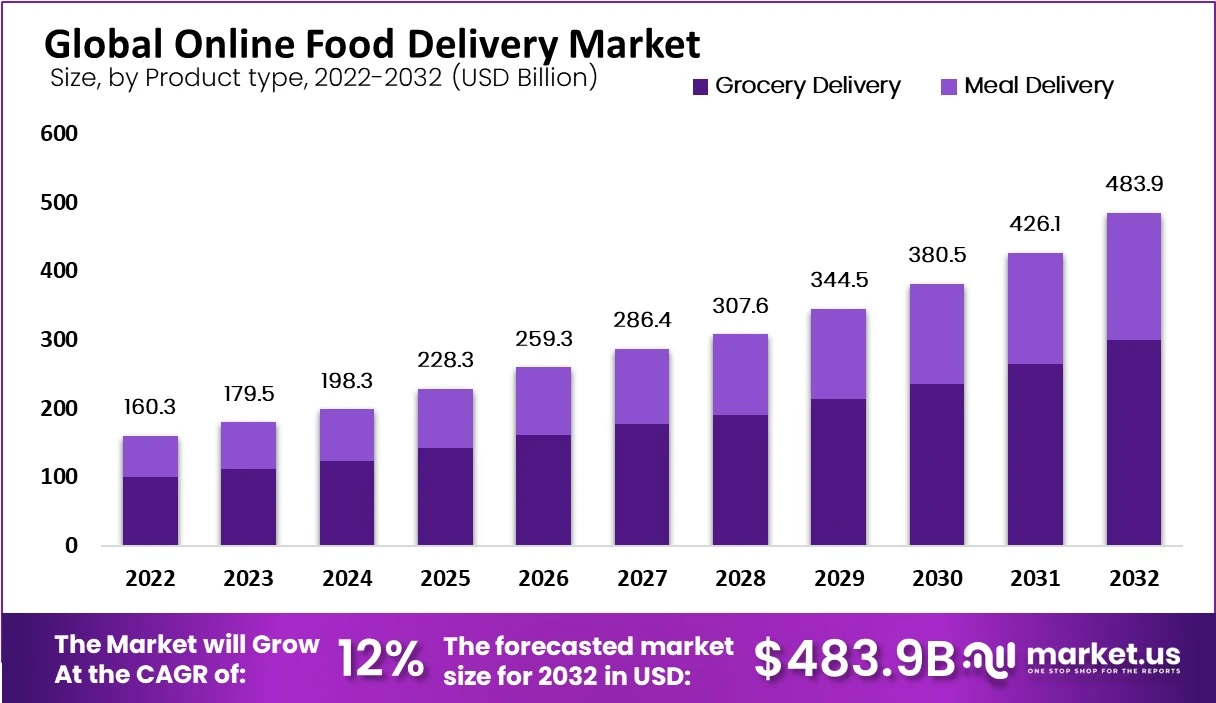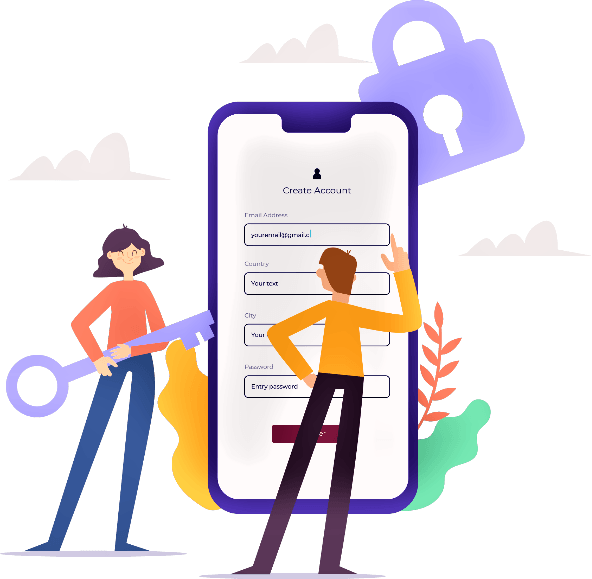How to Create A Food Delivery App: Step-by-Step Guide

In the past few years, the services providing door-to-door delivery have significantly increased, uncovering various dimensions by profiling smartphone users, Internet access, and IT enforcement in the sector. In this industry vertical, the popularity of food delivery applications is evident. With the continuously increasing demands for online food delivery and market opportunities in this sector, now is the right time to invest in customized food delivery app development.
But is there a way you can ensure your market app fills the market gap and attracts your target audience? In this blog, we’ll discuss the step-by-step process for successfully create a food delivery app. RG Infotech offers a perfect solution to your users and provides amazing features, ensuring a seamless experience through expert services for food delivery application development.
What Makes The Best Food Delivery Apps Popular Among Users?
The main reason why people prefer online food delivery apps is convenience. But other important factors contributing to its growth are discounts, easy payments, unlimited options, etc. The involvement of such features has attracted lots of attention and praise, making it so addictive that now users prefer online food delivery over visiting a restaurant. The market of online food delivery is expected to reach USD 483.9 billion by 2033, with a projected CAGR of 12%, all thanks to the technological advancements and ever-changing preferences of consumers. Furthermore, 60% of restaurant owners admit that embracing online food delivery has significantly added sales to their business.

How Does A Delivery App Work?
One crucial step in learning how to develop a successful food delivery app is to understand its functionality and operations. A delivery app serves as a link connecting customers with restaurants, grocery stores, or other retail outlets. It’s quite simple: upon installation of the app and setting up your account, you can search for and select products or food you want.
Upon placing the order, the app sends a notification to a nearby delivery person to collect the order and bring it to your doorstep. You can track the progress of your order with the app’s real-time tracking feature. It will show you exactly when to expect your delivery. You can also make payments through the app, which means you can pay for your order and tip your delivery person without the need for cash or face-to-face interaction. This efficiency and convenience are the reasons for the popularity and success of food delivery apps and the expansion of restaurant food delivery app development companies.
Don’t just crave it, create it! Learn how to build your own food delivery app with our expert guide.
Step-by-Step Guide to Create A Food Delivery App
The food delivery industry is a competitive field with massive market competition, so it’s important to develop a food delivery app that engages the target audience. Here we present a complete step-by-step process to create an on-demand food delivery app solution. Take a look:
Step 1: Complete Market Research
The first and foremost crucial step for the success of a food delivery app is to familiarize yourself with current market trends, your target audience, and the market competition. First, analyze market trends to stay updated with the latest developments in the food delivery industry, such as emerging technologies, popular features, and changing customer behaviors.
Next, you need to identify your target audience by taking note of factors like age, location, income level, and lifestyle to tailor your app to their business requirements effectively. For the development of a ready-made food delivery app solution, you need to study your competitors by researching existing food delivery applications, analyzing their strengths and weaknesses, and pinpointing areas that need improvement.
Evaluate the market demand by assessing factors like urbanization and population density in your target area to ensure a large user base. Finally, gather customer feedback through surveys to understand their issues with existing services and what features they desire in a new app. This thorough market research will provide valuable insights to guide in making an online food delivery app that stands out in a competitive market.
Step 2: Choosing The Right Food Delivery App Development Company
When it comes to food ordering app development, selecting a reputable and trustworthy partner is crucial. The team of app developers you choose will have a major impact on the future of your app. It will impact their app functions as well as the user experience. Here are some things that as a business owner you need to consider while choosing a mobile app development company:
Experience: Hire developers from a reputable app development firm that has a proven track record of developing popular and successful food delivery apps.
Expertise: Make sure that the company or team of developers you hire has the necessary skills and expertise required for the systematic and seamless development of the app. The expertise may include areas such as front-end and back-end development, database management, and API integration.
Flexibility: On-demand food delivery app development can be a challenging task for any development firm because of its complexities and challenging requirements. So, it’s important to choose a development team that can adapt easily to the changes requirements.
Communication: Transparent and open conversation is the key to establishing a successful and reliable partnership. So, make sure to choose developers/designers wisely and make sure they engage and respond to your requirements and suggestions and communicate transparently and straightforwardly.
Step 3: Customize Your Food Delivery App to Reflect Your Brand
The next step after choosing your app builder is to personalize your app so that users can recognise and become comfortable with it, which will strengthen your brand. Beyond aesthetics, customisation includes adding your logo, using the color palette of your on-demand food delivery online app development company, and choosing fonts that complement your visual style. You can quickly customize the app to make sure every element matches how you want your brand to be portrayed by starting with templates.
The degree of personalisation contributes to the development of a dependable brand experience that increases customer loyalty and trust. By including the distinctive elements of your brand and keeping the overall design consistent, you may increase user engagement and set your app apart from competitors. Now let’s move on to the next topic, the development cost of a food delivery app.
Step 4: Consider the Food Delivery App Development Cost
The food delivery app development cost can differ depending on its complexity and features. A basic app with essential functionalities like user registration, restaurant listings, menu browsing, and simple ordering may cost between $5,000 and $20,000. As the app’s features become more advanced, such as advanced search options, payment integration, real-time order tracking, and custom UI/UX design, the food ordering app’s development cost can range from $20,000 to $100,000 or more.
It’s essential to consider factors like platform (iOS, Android, or cross-platform), backend infrastructure, and ongoing maintenance costs when estimating the overall development budget. Working with an experienced food delivery app developer can help ensure that the app is developed efficiently and within budget constraints.
Also Read: Mobile App Development Cost
Step 5: Incorporate Essential Features
After knowing the cost of developing a food delivery app, now it’s time to discuss the features. Incorporating these essential features into your food delivery online app will create a seamless and engaging user experience. While providing food delivery app development services, it’s imperative to include a wide range of features tailored to different user roles:
- Clients: For clients, the app should offer intuitive registration and profile management, comprehensive restaurant listings with advanced search options, a detailed menu, seamless order placement, robust customer support channels, etc. These features ensure a smooth and satisfying ordering experience for users.
- Couriers: Couriers require features such as easy registration and profile management, efficient order management tools with real-time notifications and navigation, earnings tracking, and customer feedback mechanisms. Food delivery app developers need to include such features to empower couriers to efficiently organize and manage their deliveries and provide excellent service to customers.
- Administrators: Administrators need a dashboard with comprehensive analytics and reporting tools to monitor orders, deliveries, and user activity. They also require features for restaurant and menu management, order handling, courier management, security measures, etc. These features empower administrators to effectively manage all aspects of the food delivery platform.
By incorporating these features, your food delivery app can deliver a seamless and satisfying experience for clients, couriers, and administrators.
Step 6: Populate Your App with Content
To effectively populate your food delivery app with content, focus on providing users with valuable information and engaging experiences. Start with selecting a diverse range of restaurants that offer multiple cuisines and dining options. Large menus with detailed descriptions and enticing pictures of dishes make them easier to understand for users and help them make informed decisions. Showcase ongoing promotions, discounts, and special offers from participating restaurants to incentivize orders and drive user engagement. Promote user-generated content for ratings, reviews, and images. To enhance the authenticity factor and trustworthiness.
Step 7: Designing the Food Delivery App
According to the top food delivery app developer, the layout of the app should be simple to use, visually appealing, and practical. It must incorporate essential features and functionalities. The features may include simple navigation, filter choices, a restaurant and menu item search feature, a quick and safe ordering process, a real-time order tracking feature, and practical payment alternatives.
Another crucial element of a well-designed and developed app is prioritizing the preferences of users, including adaptable profiles, personalized recommendations, and the integration of a seamless social network platform for simple sharing and rating of food experiences. A design created by considering user preferences can improve the overall user experience and increase your food delivery app’s chances of success.
Step 8: Development phase
Now that the app’s design is complete, development can start. You need to hire food delivery app developers from a reputable food delivery app development company to ensure seamless and timely development. This phase includes tasks like coding the app’s functionality and incorporating all essential features. Optimizing the app for performance is essential to making sure it loads quickly and runs without a hitch.
One way to develop meal delivery apps is to start with a minimum viable product (MVP). Your application can be developed with all the necessary features and functionality by an expert MVP development company, enabling you to introduce it to the market with actual users. By getting user feedback, you may optimize user acceptability and experience over time by iteratively improving and enhancing your app based on their input. With this iterative process, you can start by concentrating on the most important aspects and then progressively add more functionality as required.
Step 9: Testing Across Devices
A reputable software testing business should conduct routine testing throughout the app’s development to identify and rectify any flaws or issues. Testing should encompass various hardware and operating systems to ensure the software’s usability across different devices. According to the best food delivery app development company, this comprehensive testing approach ensures the app meets quality standards and delivers a seamless experience to users.
Step 10: App Launch and Marketing
For a successful launch and effective marketing of your food delivery app, ensure you build anticipation through teaser campaigns, optimize your app for app stores, conduct beta testing, and organize a launch event. After the launch, focus on user onboarding, collecting feedback, and continuous improvement based on user insights. Utilize social media, content marketing, paid advertising, email marketing, and referral programs for effective promotion.
Conclusion
The above-provided details and information talk about the step-by-step guide to create a food delivery app, covering key aspects such as planning, design, development, testing, and launch. By leveraging the above steps, insights, and strategies, you can navigate the complexities of food delivery app development and create a standout food ordering app that delights users and establishes a strong presence in the market.
Frequently Asked Questions (FAQs)
The development timeline depends on factors like app complexity, features, and team size. Typically, it can take anywhere from a few months to a year to develop and launch a food delivery app.
Technologies commonly used include programming languages (such as Java, Kotlin, and Swift), frameworks (such as React Native, and Flutter), databases (such as MySQL, and MongoDB), and APIs (such as payment gateways, and mapping services).
The typical food delivery app development cost ranges between $10,000 to $50,000. Even so, it can differ depending on numerous factors that we discussed above. Hence, choosing the right company for the development of your app that also fits your budget is extremely important.
Challenges include ensuring timely and reliable delivery, maintaining food quality during transit, managing inventory and order fulfillment, handling peak demand periods, ensuring data security and privacy, and complying with regulations and licensing requirements.



 rgisales
rgisales



